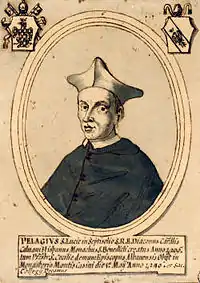Pelagio Galvani
Pelagio Galvani[1] (c. 1165 – 30 January 1230,[2] Portuguese: Paio Galvão Latin: Pelagius) was a Leonese[3] cardinal, and canon lawyer.[4] He became a papal legate and leader of the Fifth Crusade.
Pelagio Galvani | |
|---|---|
| Cardinal | |
 | |
| Church | Roman Catholic |
| Orders | |
| Created cardinal | 1205 by Innocent III |
| Personal details | |
| Born | c. 1165 |
| Died | 30 January 1230 (aged 64–65) Monte Cassino |
| Buried | Monte Cassino |
| Nationality | Portuguese |
| Coat of arms |  |
Born at Guimarães, his early life is little known. It is repeatedly claimed that he entered the Order of Saint Benedict but this is not proven.[5] Pope Innocent III created him cardinal-deacon of Santa Lucia in Septisolio around 1206.[6] Later, he was promoted to the rank of cardinal-priest of S. Cecilia (probably on 2 April 1211[7]), and finally opted for the suburbicarian see of Albano in the spring of 1213. He subscribed the papal bulls between 4 May 1207 and 26 January 1230. He was sent on a diplomatic mission to Constantinople in 1213.[8] During this two-year mission he attempted to close Orthodox churches and imprison the clergy, but this caused such domestic upset that Henry of Flanders, the Latin Emperor of Constantinople, reversed his actions which had caused the "tempest which held the city of Constantine in its grip", as noted a contemporary historian.[9] Three years later he was elected Latin Patriarch of Antioch but his election was not ratified by the Holy See. He was dispatched in 1218 by Pope Honorius III to lead the Fifth Crusade at Damietta in Egypt, and made a poor strategic decision in turning down favourable peace offers made by the sultan al-Kamil. During his absence, the see of Albano was administer by Thomas of Capua.
He became dean of the Sacred College of Cardinals at the election to the papacy of Cardinal Ugolino Conti, who became Pope Gregory IX, on 19 March 1227.[10] He was one of the leaders of the papal army in 1229–1230 during the War of the Keys against the Emperor Frederick II.[11] He died at Monte Cassino and was buried there.
References
- Akropolites, George (Ruth Macrides, ed). The History. Oxford: University Press, 2007.
- Joseph P. Donovan (1950), Pelagius and the Fifth Crusade
- Werner Maleczek (1984), Papst und Kardinalskolleg von 1191 bis 1216, Vienna
- Miranda, Salvador. "GALVÃO, O.S.B., Paio (ca. 1165-1230)". The Cardinals of the Holy Roman Church. Florida International University. OCLC 53276621.
- Araldica Vaticana
- Peter Linehan: The Spanish Church and the Papacy in the 13th Century, Ch. 12 (Spaniards at the Curia)
Notes
- Galvani is a Latin form; he is listed also as Pelágio Galvão, Pelayo Gaytan, Pelagio di Santa Lucia, Pelagius of Albano, Pelagius of St. Lucia, Pelagius Albanensis. According to Maleczek, p. 166 note 320, this commonly accepted family name of Pelagio remains uncertain because is based only on the fact, that one of his nephew was called with this familiar denomination; Maleczek observes that it is possible that this relationship was on the maternal side.
- In older historiography (e.g. Pius B. Gams, Series episcoporum Ecclesiae catholicae, p. XXII) death of Cardinal Pelagio is postdated by 10 years (to 1240). The correct date is given by Peter Linehan: The Spanish Church and the Papacy in the 13th Century, Ch. 12 (Spaniards at the Curia), Donovan, p. 115, and Maleczek, p. 169. The latest source adds that on 23 July 1230 the cardinal is referred to as of bone memorie.
- Some sources indicate that he was Portuguese, but Antonio García y García, ‘La canonística ibérica (1150–1250)en la investigación reciente’, Bulletin of Medieval Canon Law, 11 (1981), 41–75, at pp. 54–55; and Maleczek, p. 166, have proven that several contemporary documents attest his Leonese origins. Perhaps he was Galician.
- "Archived copy". Archived from the original on 2007-10-16. Retrieved 2007-10-30.
{{cite web}}: CS1 maint: archived copy as title (link) - According to Maleczek,p. 166, the theory that he was Benedictine is based only on the fact that he died at Montecassino, and, therefore, his death has been recorded in the necrology of the abbey.
- S. Miranda places his promotion in 1205. Maleczek, p. 290 and 385, says that he was possibly created in the great consistory celebrated on 27 May 1206 but that the first documentary certification of his cardinalate is dated May 4, 1207. In any case, he was created no later than in the spring of 1207.
- Maleczek, p. 290
- Maleczek, p. 167
- George Akropolites, p. 155.
- He was cardinal-bishop next to Ugolino Conti in the order of seniority.
- Maleczek, p. 169